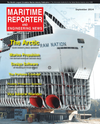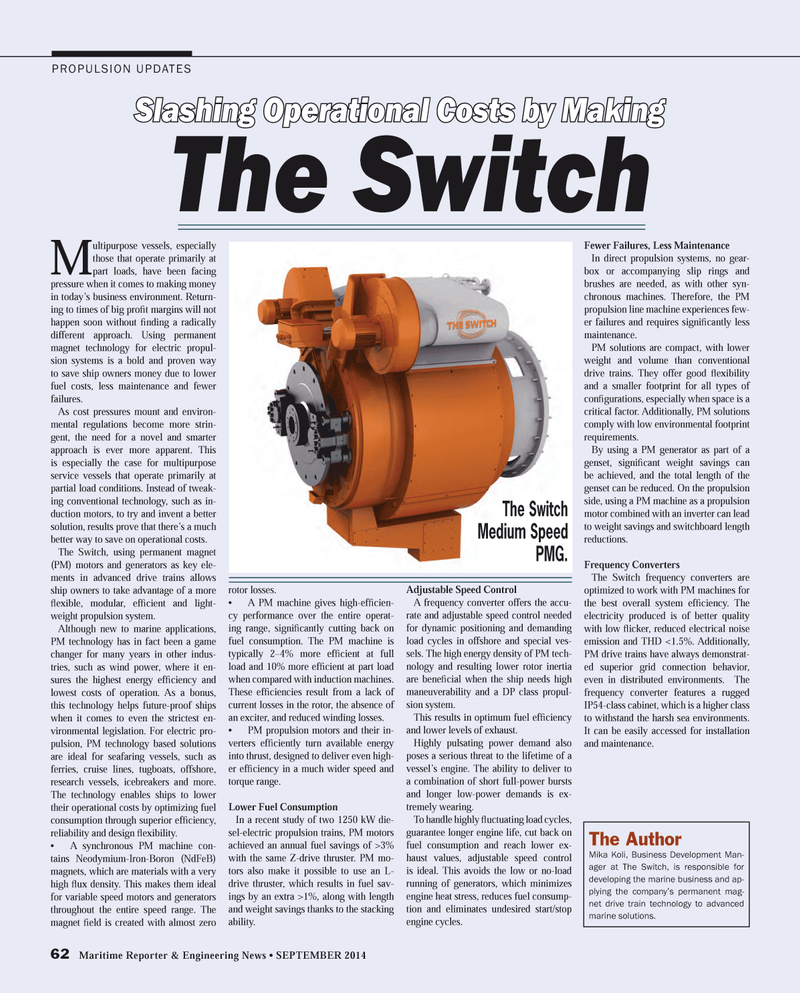
Page 62: of Maritime Reporter Magazine (September 2014)
Marine Propulsion Edition
Read this page in Pdf, Flash or Html5 edition of September 2014 Maritime Reporter Magazine
PROPULSION UPDATES
M ultipurpose vessels, especially those that operate primarily at part loads, have been facing pressure when it comes to making money in today’s business environment. Return- ing to times of big profi t margins will not happen soon without fi nding a radically different approach. Using permanent magnet technology for electric propul- sion systems is a bold and proven way to save ship owners money due to lower fuel costs, less maintenance and fewer failures.
As cost pressures mount and environ- mental regulations become more strin- gent, the need for a novel and smarter approach is ever more apparent. This is especially the case for multipurpose service vessels that operate primarily at partial load conditions. Instead of tweak- ing conventional technology, such as in- duction motors, to try and invent a better solution, results prove that there’s a much better way to save on operational costs.
The Switch, using permanent magnet (PM) motors and generators as key ele- ments in advanced drive trains allows ship owners to take advantage of a more fl exible, modular, effi cient and light- weight propulsion system.
Although new to marine applications,
PM technology has in fact been a game changer for many years in other indus- tries, such as wind power, where it en- sures the highest energy effi ciency and lowest costs of operation. As a bonus, this technology helps future-proof ships when it comes to even the strictest en- vironmental legislation. For electric pro- pulsion, PM technology based solutions are ideal for seafaring vessels, such as ferries, cruise lines, tugboats, offshore, research vessels, icebreakers and more.
The technology enables ships to lower their operational costs by optimizing fuel consumption through superior effi ciency, reliability and design fl exibility. • A synchronous PM machine con- tains Neodymium-Iron-Boron (NdFeB) magnets, which are materials with a very high fl ux density. This makes them ideal for variable speed motors and generators throughout the entire speed range. The magnet fi eld is created with almost zero rotor losses. • A PM machine gives high-effi cien- cy performance over the entire operat- ing range, signifi cantly cutting back on fuel consumption. The PM machine is typically 2–4% more effi cient at full load and 10% more effi cient at part load when compared with induction machines.
These effi ciencies result from a lack of current losses in the rotor, the absence of an exciter, and reduced winding losses. • PM propulsion motors and their in- verters effi ciently turn available energy into thrust, designed to deliver even high- er effi ciency in a much wider speed and torque range.
Lower Fuel Consumption
In a recent study of two 1250 kW die- sel-electric propulsion trains, PM motors achieved an annual fuel savings of >3% with the same Z-drive thruster. PM mo- tors also make it possible to use an L- drive thruster, which results in fuel sav- ings by an extra >1%, along with length and weight savings thanks to the stacking ability.
Adjustable Speed Control
A frequency converter offers the accu- rate and adjustable speed control needed for dynamic positioning and demanding load cycles in offshore and special ves- sels. The high energy density of PM tech- nology and resulting lower rotor inertia are benefi cial when the ship needs high maneuverability and a DP class propul- sion system.
This results in optimum fuel effi ciency and lower levels of exhaust.
Highly pulsating power demand also poses a serious threat to the lifetime of a vessel’s engine. The ability to deliver to a combination of short full-power bursts and longer low-power demands is ex- tremely wearing.
To handle highly fl uctuating load cycles, guarantee longer engine life, cut back on fuel consumption and reach lower ex- haust values, adjustable speed control is ideal. This avoids the low or no-load running of generators, which minimizes engine heat stress, reduces fuel consump- tion and eliminates undesired start/stop engine cycles.
Fewer Failures, Less Maintenance
In direct propulsion systems, no gear- box or accompanying slip rings and brushes are needed, as with other syn- chronous machines. Therefore, the PM propulsion line machine experiences few- er failures and requires signifi cantly less maintenance.
PM solutions are compact, with lower weight and volume than conventional drive trains. They offer good fl exibility and a smaller footprint for all types of confi gurations, especially when space is a critical factor. Additionally, PM solutions comply with low environmental footprint requirements.
By using a PM generator as part of a genset, signifi cant weight savings can be achieved, and the total length of the genset can be reduced. On the propulsion side, using a PM machine as a propulsion motor combined with an inverter can lead to weight savings and switchboard length reductions.
Frequency Converters
The Switch frequency converters are optimized to work with PM machines for the best overall system effi ciency. The electricity produced is of better quality with low fl icker, reduced electrical noise emission and THD <1.5%. Additionally,
PM drive trains have always demonstrat- ed superior grid connection behavior, even in distributed environments. The frequency converter features a rugged
IP54-class cabinet, which is a higher class to withstand the harsh sea environments.
It can be easily accessed for installation and maintenance.
Slashing Operational Costs by MakingSlashing Operational Costs b
The Author
Mika Koli, Business Development Man- ager at The Switch, is responsible for developing the marine business and ap- plying the company’s permanent mag- net drive train technology to advanced marine solutions. 62 Maritime Reporter & Engineering News • SEPTEMBER 2014 The Switch
The Switch
Medium Speed
PMG.
MR #9 (58-65).indd 62 9/3/2014 10:58:04 AM

 61
61

 63
63
